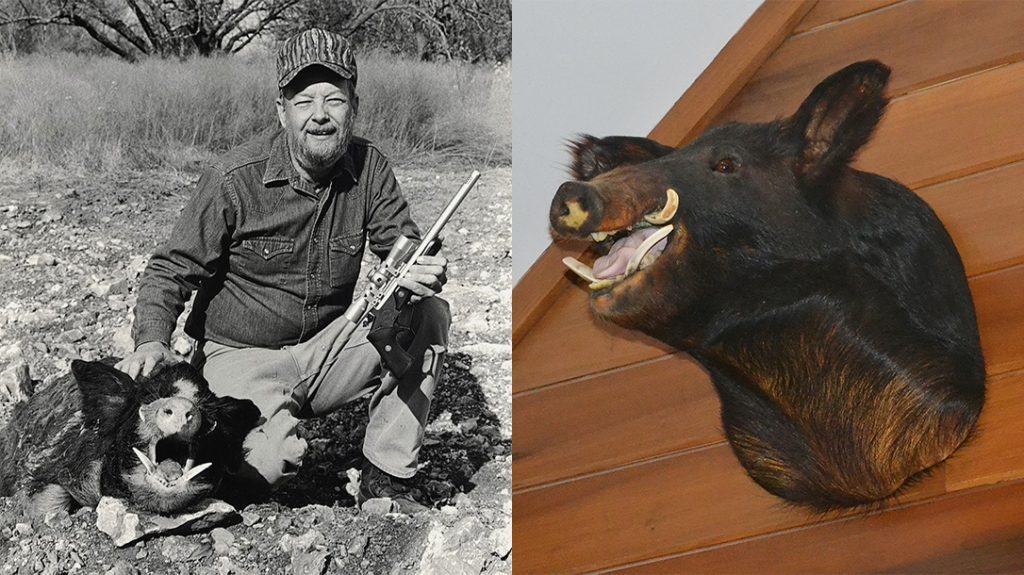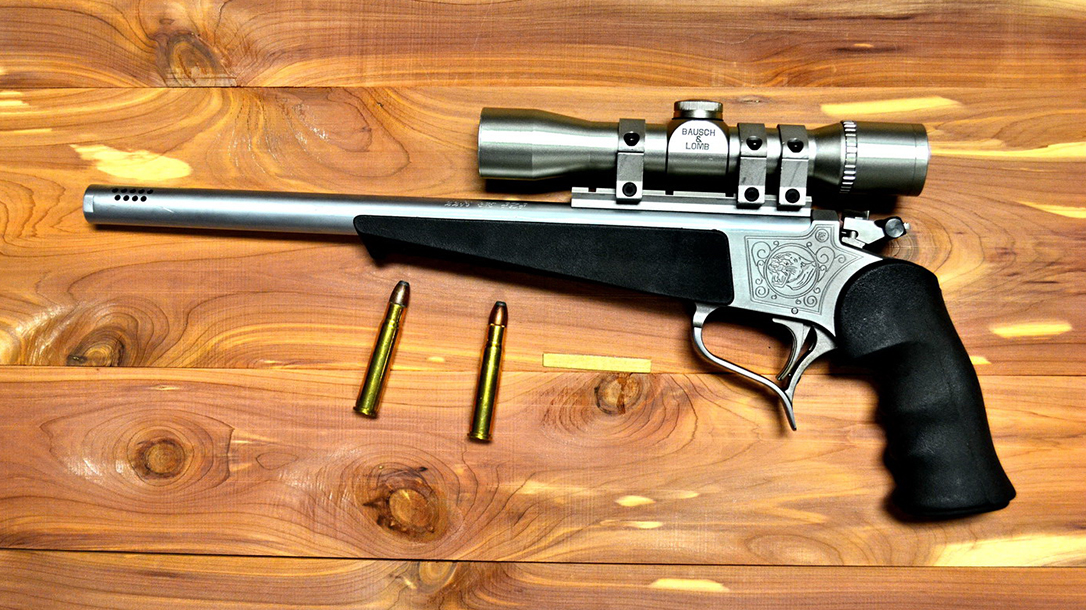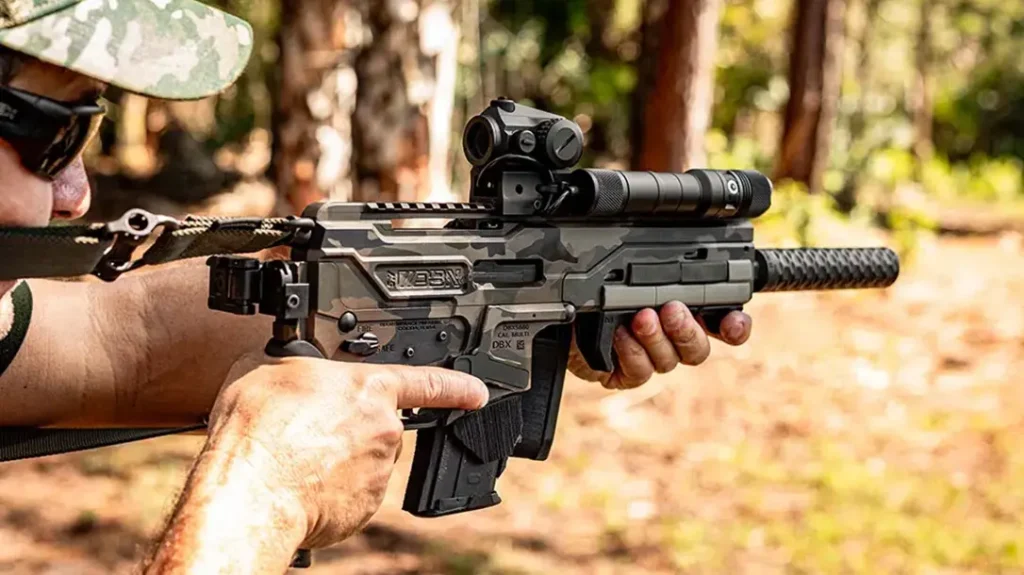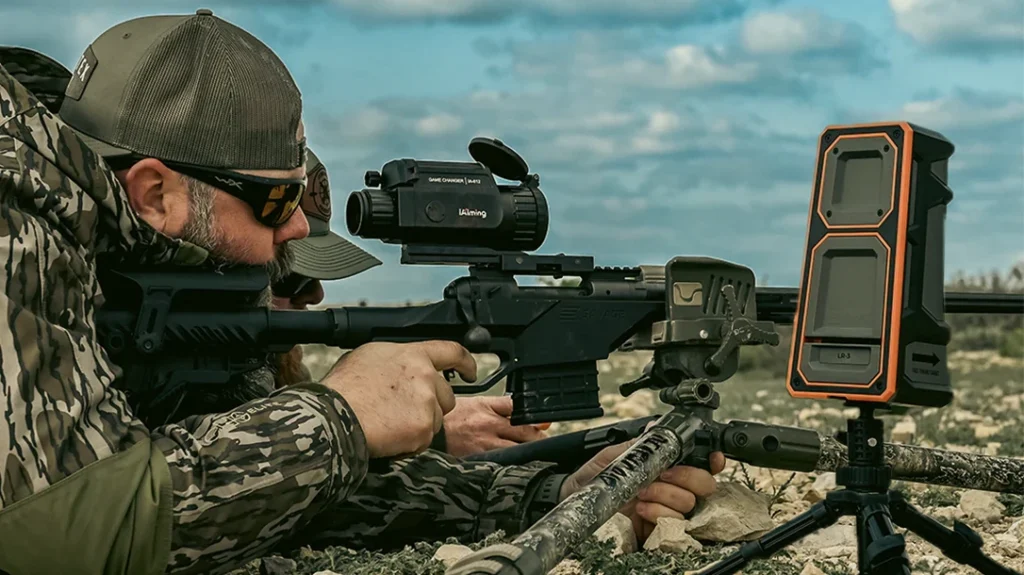Big bores for big boars — makes sense, right? Try a Thompson/Center Contender in .375 JDJ. Why go with that? Let’s dive in. Many hunters equate wild hog hunting to grizzly hunting at a fraction of the cost. It’s exciting, usually occurs at close range and is best done with big-bore calibers firing heavy, deep-penetrating bullets that carry a lot of energy to the target.
Feral hogs have been called the “low-budget grizzly,” and with good reason. Feral hogs, both boar and sow, can be dangerous animals to hunt under the right set of circumstances. Due to their size, build and sharp senses, they can test the hunter’s skills and the “knockdown power” of many calibers. I’ve seen a large boar take a hit from a .308 Winchester and stay on its feet, ready to fight. They do have some of the same “pucker factor” qualities of a grizzly at a much lower cost.
Feral hog populations in the U.S. are soaring, and while they’re a problem to rural landowners, they offer a great hunting opportunity to those who like to use big-bore calibers. Also, since they’re considered a nuisance animal in most states, they can be hunted year-round.
Advertisement — Continue Reading Below
Lever-Actions and Boars
Wild hogs are built to be tough. Their body build resembles that of a buffalo, being higher and heavier in the shoulder region. For defense, the wild hog has some formidable armor in the form of an extremely thick layer of cartilage over each shoulder. On large hogs, it can stop most small-caliber or poorly constructed bullets.
The boar is armed with long canine tusks that protrude from the lower jaw. The length of these tusks can reach up to 6 inches or more. Mounted on a plaque, they make a great addition to any trophy room. These tusks are razor sharp and can be deadly to hunters and dogs alike.
An extremely large feral boar might weigh 600 pounds or more, but it doesn’t have to be large to be mean. I’ve seen an 85-pound sow with piglets put up a good fight and prove difficult to put down for keeps.
Advertisement — Continue Reading Below
Close-range boar hunting is an ideal opportunity to use the modern version of the traditional lever-action rifle to shoot deep-penetrating bullets. The .45-70 Government shooting Black Hills 325-grain HoneyBadger, Hornady 325-grain FTX LEVERevolution or Garrett 420-grain SuperHardCast Hammerhead ammo can be deadly to big boar. The .444 Marlin shooting Hornady 265-grain FTX LEVERevolution, the .35 Rem shooting Hornady 200-grain FTX LEVERevolution or even the .30-30 Win shooting Hornady 160-grain FTX LEVERevolution with good shot placement at short ranges can be ideal hog killers, just to name a few.
My Thompson/Center Contender in .375 JDJ
While I’ve taken short-range wild boar with a variety of handgun calibers, including .454 Casull, .41 Magnum, .44 Magnum, .45-70, .375 Win. and .35 Rem., when hunting large hogs, I usually elect to use my Thompson/Center Contender frame equipped with an SSK Industries 14-inch barrel chambered in .375 JDJ. Yes, it’s a single-shot handgun, but when good shot placement is employed, one shot is usually enough for even the largest boar.
The well-known .375 JDJ wildcat cartridge is an interesting hunting cartridge for the handgun. It’s formed by necking down the .444 Marlin case to a .375. It has a reputation for putting down elephants, Cape buffalo, moose, elk and grizzly bear, as well as wild boar.
Advertisement — Continue Reading Below
As one might expect, the .375 JDJ cartridge generates a lot of muzzle blast and recoil, but SSK Industries ports the barrel so that both are manageable. Shooting my .375 JDJ Thompson/Center Contender is about like shooting a heavily loaded .44 Magnum.
My Texas Boar Hunt
One of my most memorable hunts for wild boar using the .375 JDJ came when a hunting-guide friend, Johnnie Hudman of Albany, Texas, called one spring morning. During the conversation, he told me that with all the rain they’d had around Albany, the hogs had plenty to eat and he was seeing lots of boar with 3-inch or longer tusks. His invitation to a handgun hunt was quickly accepted. I grabbed my Thompson/Center Contender and hit the road.
Within a few days, I was on a canyon rim with Hudman watching a beautiful Texas sunrise. Far below, in a prickly pear flat near a dry wash, we watched five large hogs feeding. Trophy judging was impossible as the broom weed was so high, thanks to all the rain, and it hid the hogs’ heads. We elected to work our way around the canyon until we got the wind in our favor and then stalk up to the hogs to get a better look.
Advertisement — Continue Reading Below
Spotting the Big Boy
It took us the better part of the morning to get within 50 yards of the hogs. We were hidden in the branches of a mesquite tree using a limb to steady our binoculars when the hogs reached an opening in the grass. “No long tusks,” Hudman whispered. “The only tusk showing is on that next-to-the-last hog, and his tusks are only an inch or so.” I agreed, and we eased out of the flat and started the long walk back to his truck.
Mid-afternoon found us bumping along a rocky ranch road to a high ridge where one of the ranch cowboys had seen several large boars. Since daybreak, I had studied some 70 hogs, but I hadn’t found one I wanted.
Suddenly, Hudman stopped the truck and grabbed his binoculars off the dashboard. “There are three big hogs on that grassy slope,” he said as he looked out his truck window. All I could see were two black dots in the grass some 600 yards away.
Advertisement — Continue Reading Below
“Are you up to a long stalk?” he asked. “We’ll have to go around the hill they’re on and come up over the hill above them to keep the wind in our favor,” he added.
I didn’t answer, but I got out of the truck ready to go.
The Trek
It took us almost an hour to go around the hill. The stalk took us across a grassy pear flat, and we were covering ground fast when Hudman dropped to the ground and put his finger to his lips. There in the tall grass just 35 yards in front of us stood several hogs. I quickly set up my cross-sticks and prepared for a possible shot as Hudman studied the uneasy hogs. They’d heard us but didn’t know what we were.
Advertisement — Continue Reading Below
“There’s a boar in the bunch with about 2.5-inch tusks,” he whispered, “but the rest are sows and pigs.”
“Let’s ease around them and go for the big boy,” I whispered. Hudman nodded, and we backtracked and went around the hogs.
Soon, we were crawling on our knees to peer over the hill. “Damn,” Hudman whispered. “They’ve moved all the way to the bottom of the hill. We’ll have to take advantage of all the cover available to us.”
Advertisement — Continue Reading Below
Slowly, my hunting buddy and I picked our way down the hill and stopped just before reaching the flat. Using our binoculars, we studied the hogs. Two were big boars with long tusks. One was a black-and-brown boar with tusks that I estimated were more than 4 inches long. This was the hog I came to Texas to hunt.
They fed some 250 yards away, and I wanted to close the distance as much as I could before I shot. So, the slow crawling began. As I observed the wind, I also watched where I put my hands and knees, as there were low-growing cacti everywhere, and it was warm enough for rattlesnakes to be out.
Taking the Shot
I crawled from mesquite bush to mesquite bush—200 yards, 150 yards and 100 yards. At each bush, I checked on my target’s whereabouts. At a dead tree some 75 yards from the feeding boar, I stood up to check on him when an unseen hog just to my right squealed and ran. The big spotted boar raised his head and looked my way. There was no time to consider what to do next. I laid the Thompson/Center Contender on a sturdy limb, cocked the hammer, found the boar’s shoulder in the scope, placed the reticle on the lower part of the shoulder and squeezed off a round. I heard the bullet smack the hog, but looking through the scope, I saw nothing due to the recoil.
Advertisement — Continue Reading Below
Looking back at Hudman, I saw a blank look on his face. “I was too low to see the hog well, but I saw dust fly off him. I think you rolled him,” he reported. “Let’s wait a few minutes.”
I reloaded and we waited about 20 minutes.
“Let’s ease up there slowly, and keep that hand cannon ready,” he whispered.
We made the walk watching in every direction for any sudden movement. As we neared the last place where I’d seen the hog, I spotted him, down for the count. The .375 bullet had gone through both shoulders.
“He’ll make a really good tusk mount,” Hudman said as he leaned down to examine the tusk. “They might make 6 inches.”

Wild-boar hunting is becoming much more plentiful throughout much of the country, and the good thing is that it is usually available during the off-season. So, get out there and see for yourself what trophies you might be able to add to your collection. For even more on the Thompson/Center Contender, please visit TCarms.com.
Beware the Dangers of Wild Meat
While feral hogs can be fun to hunt, there are some cautions that need to be understood: They can carry diseases that can be transmitted to humans. This report comes to us from the University of North Carolina’s Cooperative Extension service. It emphasizes the need to wear latex gloves when dressing wild hogs.
At his deer camp, a 27-year-old hunter field-dressed and quartered several white-tailed deer and feral hogs after a successful hunt. He was unaware that a wild hog he was cleaning was infected with bacteria that cause brucellosis and that he could contract this and other diseases simply by touching the contaminated meat. Since he wasn’t wearing latex gloves, a nick or briar scratch on his hands or arms would provide enough of a cut for infection to result.
The takeaway here is to practice safety first when in the field. Always wear latex gloves while cleaning and dressing wild game. When finished, scrub your hands and arms carefully with antibacterial soap to kill any lingering bacteria. Thoroughly cook all meat—from wild game to domestic livestock—before eating, and live to hunt another day.
























